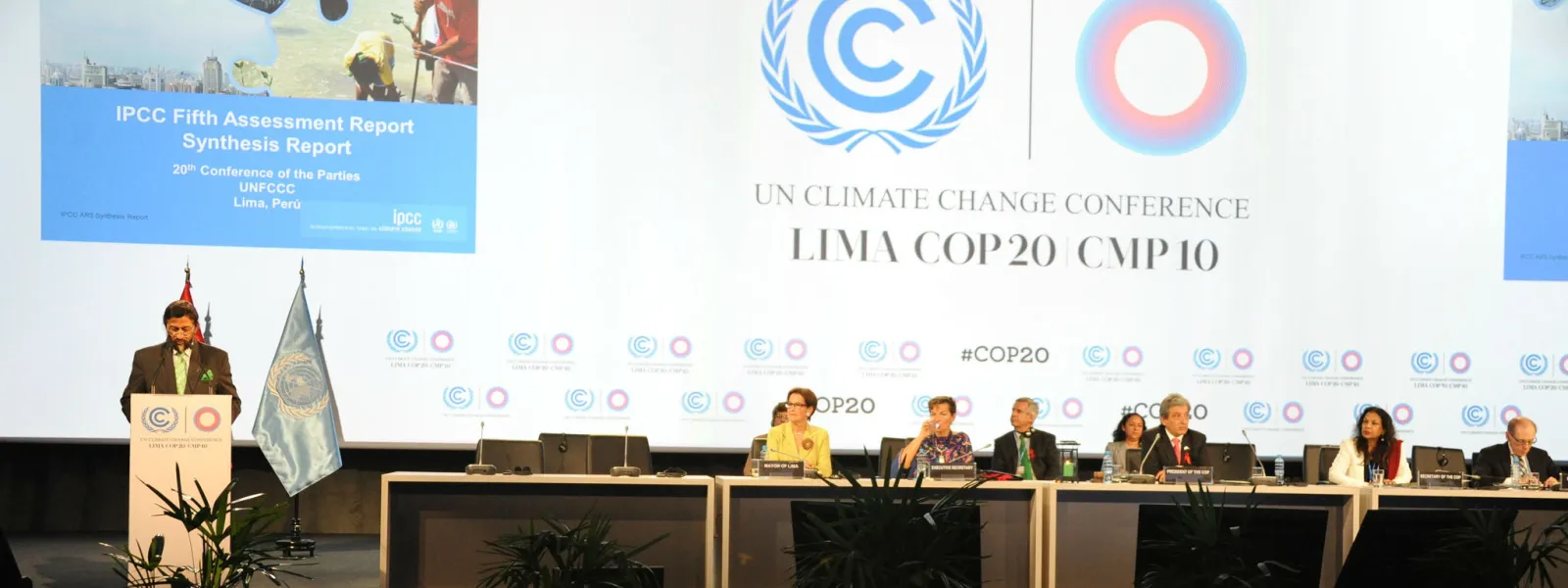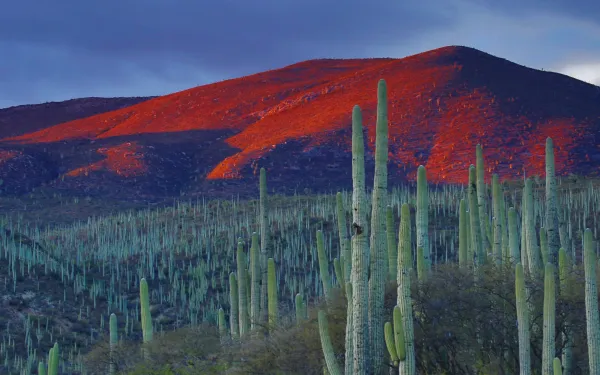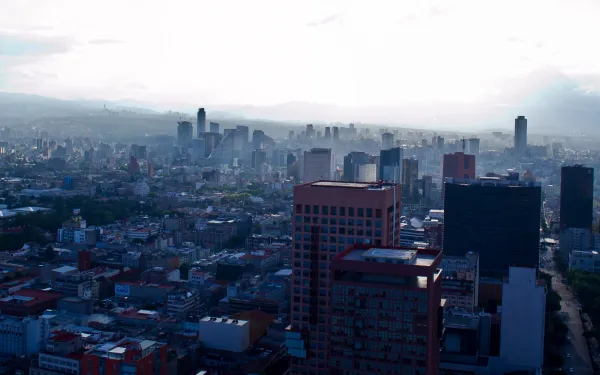
Project
Photo: UNFCCCMonitoring the UN Climate Negotiations
As changes in climate become more extreme, their affects are being hardest felt throughout developing countries. Since 1994, the United Nations Framework Convention on Climate Change has laid out actions to limit the increase of global average temperatures and confront the impacts of climate change.
The States that are Parties to the Convention meet every year in the so-called Conference of the Parties (COP) to review their commitments, the progress made in fulfilling them, and pending challenges in the global fight against the climate crisis.
At COP21 in 2015, they adopted the Paris Agreement, which seeks to strengthen the global response to the climate emergency, establishing a common framework for all countries to work on the basis of their capacities and through the presentation of Nationally Determined Contributions (NDC) that will:
- Limit the increase in global temperatures to 2°C compared to pre-industrial levels and continue efforts to limit it to 1.5°C;
- Increase the capacity of countries to adapt to the impacts of climate change; and
- Ensure that financing responds to the goal of reducing greenhouse gas emissions.
Our focus areas
THE CLIMATE CRISIS AND HUMAN RIGHTS
The climate crisis, due to its transversal character, has repercussions in various fields, geographies, contexts and people. In this regard, the Preamble to the Paris Agreement states that it is the obligation of States to "respect, promote and fulfill their respective obligations on human rights, the right to health, the rights of indigenous peoples, local communities, migrants, children, persons with disabilities and people in vulnerable situations and the right to development, as well as gender equality, the empowerment of women and intergenerational equity."
AIDA at the COP
COP25: Chile-Madrid 2019
At COP25 in Madrid, Spain, we advocated for the inclusion of the human rights perspective in various agenda items. We promoted the incorporation of broad socio-environmental safeguards in the regulation of Article 6 of the Paris Agreement, which refers to carbon markets. We closely followed the adoption of the Gender Action Plan, as well as the Santiago Network, created "to catalyze technical assistance […] in developing countries that are particularly vulnerable to the adverse affects of climate change." We also encouraged the inclusion of ambitious and measurable targets for the reduction of short-lived climate pollutants in the climate commitments of States.
Related projects

Challenges and conditions to advance towards energy justice in Mexico
This blog entry accompanies the launch of the first ever Benchmark on Renewable Energy and Human Rights. It was originally published by the Business & Human Rights Information Centre. By Rosa Peña Lizarazo and Astrid Puentes Riaño The climate crisis, in the words of Michelle Bachelet, the UN High Commissioner for Human Rights, is the greatest current threat to human rights, and one that requires urgent political decisions and collective action. One such decision concerns progress in the energy transition, that is, the shift from the use of energy derived from fossil fuels to the use of energy that is renewable and less emission-intensive. By reducing greenhouse gas emissions, this transition would help to address the climate crisis and improve air quality. In Mexico, this transition has motivated multi-sector debates and requires a participatory, inclusive, and transparent dialogue with a human rights approach and a territorial perspective. There are four main challenges to this: main challenges 1. The socioeconomic context Mexico has some of the highest levels of inequality on the planet, with ten of the country’s richest people holding wealth the equivalent to 50% of its poorest. Understanding this context is key to adapting energy transition policies that meet international climate obligations without creating more inequity. It is also essential to learn from the past. The 2013 energy reform set in motion a model for the massive implementation of renewable energy projects, both large-scale and private. This made it impossible to overcome the wide gaps in exclusion for socio-economic and territorial reasons. 2. Energy consensus Another challenge is achieving regulatory and social consensus on what clean and renewable energy is and what the goal should be in its implementation. Despite the proposals of some environmental organizations, the Mexican Government accepted vague and more convenient definitions to fulfill its climate commitments. It defined clean energies as those that do not generate polluting emissions during their production, ignoring whether they can generate other negative impacts on the environment. 3. Respect and protection of human rights The generation of energy from fossil fuels has violated human rights, provoking scenarios of exclusion and serious implications for Mexico’s indigenous and rural communities. Likewise, many non-conventional renewable energy projects, like those developments in the Isthmus of Tehuantepec or in the Yucatan Peninsula, have generated new socio-environmental conflicts. These relate to the lack of transparency and participation, violation of the rights of native peoples, lack of knowledge of traditional ownership and uses of land, obstacles to access natural resources, and environmental degradation. It is therefore a challenge to undertake a transition that considers and prevents these harms from a human rights perspective. 4. Energy diversification and reliability Given current dependence on fossil fuels in the energy grid - which by 2018 generated 75.88% of the country's energy - progress towards mitigation and adaptation to climate change requires a process of diversification of energy sources that takes advantage of Mexico's potential to develop renewable energy. Another associated challenge is to guarantee the reliability of the system to ensure it can continuously meet the country's energy demand. how can a fair transition come about? At AIDA, we believe this can be done by building energy justice in Mexico, through the following: Adapting to the socioeconomic context: Betting on a transition that becomes an engine of local development, through for example, the generation of jobs, the democratization of energy and energy generation in the scale necessary for self-supply. This requires overcoming existing barriers to exclusion by implementing, for example, community energy projects. Designing participatory energy policy: Propose scenarios of effective and inclusive participation in order to agree on the minimum aspects of the goals of energy policy in the country, in response to the climate crisis. Compliance with environmental and human rights standards: Advisory Opinion 23 of the Inter-American Court of Human Rights highlights that any policy or project must guarantee access rights in environmental matters and labour rights, comply with the principles of prevention and precaution, respect the rights of indigenous and Afro-Mexican peoples, and have a gender perspective. Diversification of the energy grid: Promote financing mechanisms that encourage clean technological innovation and investment in decentralized renewable energies and with better storage strategies. Without a doubt, a just energy transition is necessary and urgent in Mexico. The country now has the opportunity to undertake a progressive and timely transition that allows for better scenarios of social, environmental and climate justice, and that responds to current social demands.
Read more
Mexico’s Federal Mining Law threatens human rights of indigenous peoples
International civil society organizations submitted amicus curiae briefs to the Mexican Supreme Court in support of the State of Puebla-based Masewal people’s constitutional action.Groups also delivered to the Court’s Second Chamber more than 4,000 signatures supporting the defense of indigenous people’s rights, collected through www.change.org.mx International civil society organizations are supporting a lawsuit filed by the Masewal indigenous people of Cuetzalan del Progreso, based in the Sierra Norte of the Mexican state of Puebla, against Mexico’s Mining Law. The Masewal request that the Supreme Court of Justice of the Nation (SCJN) declare the law unconstitutional because it violates indigenous peoples’ fundamental rights. Earthjustice, the Environmental Defender Law Center (EDLC) and the Interamerican Association for Environmental Defense (AIDA) filed separate amicus curiae (“friend of the court”) briefs to provide information in order to help the SCJN rule on litigation initiated by the Altepetajpianij Maseual Council and the Mexican Center for Environmental Law (CEMDA). The constitutional suit, originally filed in March 2015, argues that Mexico adopted the new Mining Law in violation of indigenous rights by not previously consulting or informing indigenous peoples before passing the law. As a result, the law failed to take into account indigenous values or perspectives and contained no mechanism to protect their human rights, even though many mining concessions already affect their territories. Above all, this law violates indigenous peoples’ rights to self-determination by excluding them from decision-making on mining within their territories, thus threatening local communities’ quality of life. “As the First Peoples, we are convinced that, in order to have a good life –Yeknemilis, as we say in Nahuatl– it is necessary that we be well and have social peace. And we cannot be well, nor can we build social peace in our territories, when extractive projects such as destructive mining threaten our way of life,” the Masewal people told SCJN justices in their brief. “Our contribution presented in our amicus brief highlights that Mexico’s international obligations require free, prior, and informed consultations with indigenous peoples before approving any legislative measure that affects them, especially when it comes to their territorial rights,” said Guillermo Zúñiga, Earthjustice international attorney. “This also includes laws on the extraction of natural resources found in their territories, which applies directly to the case of the Mining Law.” “Mining concessions cannot be granted solely based on mining legislation. A higher-level legal framework, based on human rights and environmental law, and on the interrelation between the two issues, is must be applied in this case. This broader, legal framework determines and limits the granting of mining titles in the case of lands and territories,” says EDLC in its amicus’ conclusions. "Mexico’s Supreme Court of Justice of the Nation has the opportunity to set an exemplary precedent for the region with respect to the protection of indigenous rights," said attorney Carlos Lozano Acosta of AIDA. "In turn, the SCJN can learn from regional experience, adopting the relevant standards that courts in other countries have provided in favor of indigenous peoples, as evidenced in our amicus brief." Letters of support from other indigenous groups in Mexico, Colombia, Brazil, Bolivia, and Guatemala, as well as 4,091 signatures collected through the platform change.org.mx as of June 26, were sent to the Ministers of the SCJN’s Second Chamber supporting the Masewal People's suit. press contacts Ricardo Ruiz (Mexico), CEMDA, 5559644162, [email protected] Victor Quintanilla (Mexico), AIDA, 5570522107, [email protected] Robert Valencia (US), Earthjustice, [email protected]
Read more
Contamination and COVID-19: Why didn't air quality Improve in the Valley of Mexico?
Measures adopted to deal with the global health pandemic caused by COVID-19 have led to a reduction in some atmospheric pollutants, which has considerably improved air quality in various cities around the world. Yet in the metropolitan area of the Valley of Mexico (MCMA)—which includes Mexico City and surrounding towns—air quality has not improved despite the suspension of activities associated with sources of pollution like traffic and industry. Months before the health emergency was declared in late March 2020, the air quality reported by the Valley’s Atmospheric Monitoring System was in the range of "regular" to "bad," due primarily to vehicle congestion. With restrictions on mobility established due to the pandemic, vehicle traffic decreased by up to 70% and, with it, so did some of the air pollution. According to official information, distancing measures caused a reduction in carbon monoxide and nitrogen oxides—of 58 and 32 percent, respectively. However, tropospheric ozone (O3), one of the most damaging pollutants to air quality and human health, did not decrease significantly (only 3 or 4 percent, according to official data). That’s why, in May, two months after measures were adopted to address the health crisis, air quality in the Valley of Mexico remained at the same parameters as the beginning of the year—that is, ranging from "regular" to "bad," according to the Atmospheric Monitoring System. The question that arises, then, is WHY? What causes air pollution? Various gases and compounds contaminate the air. Primary pollutants—like carbon dioxide (CO2), nitrogen oxides (NOx) and volatile organic compounds (VOC)—are directly discharged into the atmosphere. Secondary pollutants, like tropospheric ozone (O3), form in the atmosphere as a result of the chemical transformation of those primary pollutants. Tropospheric ozone is formed from the interaction of sunlight with "precursor gases," including volatile organic compounds and nitrogen oxides. Now, there are three factors that actually affect air quality: weather conditions, topography, and concentrations of one or more pollutants at levels that can harm the environment and human health. These concentrations are measured by official monitoring systems, like the MCMA Atmospheric Monitoring System. The World Health Organization establishes concentration levels of pollutants that should not be exceeded over a specific period. For tropospheric ozone, the recommended value is 50 parts per billion (ppb) over an eight-hour average. But Mexican regulations are more lax and establish a lower limit for this compound: a concentration less than or equal to 95 ppb on an hourly average (that is, in a 60-minute time interval). In addition, to activate an environmental contingency for ozone, concentrations must be greater than 154 ppb (hourly average). This standard implies less protection for the population's health. At the beginning of this year, the hourly ozone concentration in the Valley of Mexico averaged only 23 ppb, but it has risen since then. Despite the restrictions resulting from the health crisis, the average hourly concentration of ozone was 41 ppb in April and 45 ppb in May. Also, from January to May, 99 days were recorded in which ozone concentrations exceeded the 95 ppb limit. Why did concentrations of ozone increase? The restriction on mobility during the health contingency was not adequate to decrease concentrations of ozone in the atmosphere for two reasons: first, the sources of this compound are not limited to the use of vehicles; and second, the period of social isolation coincided with the so-called ozone season, a time of the year when the concentrations rise due to the increase of solar radiation and the decrease of rain and wind. As previously mentioned, tropospheric ozone is formed by the interaction of sunlight with precursor gases. Among these gases are nitrogen oxides—mainly generated by the combustion processes of automobiles, especially diesel engines—and volatile organic compounds, which arise from more diverse sources: the use of solvents, leaks of liquefied petroleum gas in heaters and stoves, cosmetic and cleaning products, and evaporated fuel in gas stations and automobiles without evaporative emissions control. According to official data, during social isolation, volatile organic compounds were only reduced by 15 percent, including all their emission sources. On the other hand are forest fires, a major source of ozone precursor gases. From January 1 to May 3 of this year, in Mexico City alone there were 644 forest fires— lower in number compared to the same period in 2019, but equally as intense. As for the ozone season, which begins the last week of February and ends with the first rains in June, the average temperature in the Valley of Mexico was higher this year. In April, it was 2°C higher than the average recorded in the same month between 1981 and 2010—the hottest April in recorded history. Because the temperature is directly related to solar radiation and lack of wind, its increase explains the higher ozone concentrations. The sum of these factors contributed to the fact that ozone concentrations actually increased despite the restrictions established by the pandemic. This, in turn, led to the residents of the Valley of Mexico continuing to experience poor air quality and suffering its negative health impacts. Why reducing ozone is good for public health and the climate Ozone not only affects air quality and thus public health. It also has the ability to absorb sunlight and heat the atmosphere, meaning it is a short-lived climate pollutant (SLCP). Because its emissions aggravate the climate crisis, more than 11,000 scientists from around the world have highlighted the need to reduce SLCPs in order to rapidly combat global warming. The intensity of the forest fires and the particularly high temperatures of this year's “ozone season” demonstrate the effects of the climate crisis that we are failing to adequately confront. That’s why it’s imperative that the government implement actions to reduce emissions of precursors gases—not only during the health emergency, but also when we get through it, when motorized transportation (a source of nitrogen oxides) is reactivated. Improved controls on the type of cars on the road, based on their polluting potential, and personal choices like biking, also recommended to reduce the risks of contagion, would help to achieve this objective, reduce global warming, and improve the health of those living in the Valley of Mexico. In addition, society must commit to measures of regulation, communication and education that curb consumer habits and improve on the production and distribution of goods and services that continue to emit volatile organic compounds (another ozone precursor) on a daily basis. Restricting the production and use of aerosol products, as well as repairing and preventing leaks of liquefied petroleum gas, would help to reduce these emissions. Finally, it’s necessary to strengthen the country's weak environmental policy and combat non-compliance with environmental health standards, which has resulted in an insufficient reduction in air pollution. Mexican air quality standards must be updated to set stricter limits that are compatible with international standards and the protection of the human right to health. The above are just some examples of actions that authorities and society can take to show that we have learned a lesson and will do what is necessary to improve air quality and face possible new health crises, as well as to combat the climate crisis that threatens to end the world as we know it today.
Read more